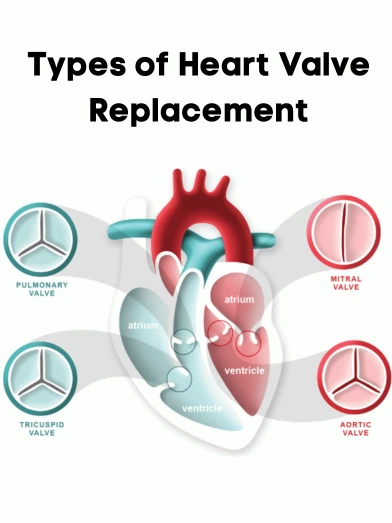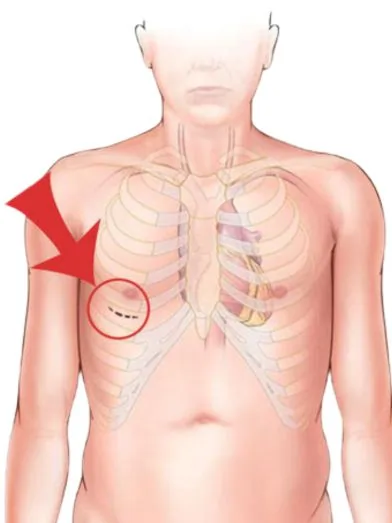Heart Valves play a vital role in the proper functioning of the heart. They regulate blood flow, ensuring that it flows in the right direction. However, when a heart valve becomes damaged or diseased, it can affect the heart’s ability to pump blood efficiently. In some cases, heart valve replacement surgery may be necessary. Traditionally, this surgery was performed as open-heart surgery, but now minimally invasive valve replacement has become a popular alternative.

The Main Types of Heart Valve Replacement
There are four main types of heart valve replacement surgeries, depending on which valve is affected:
Aortic Valve Replacement: Replacing the aortic valve, which is located between the left ventricle and the aorta, is involved in this surgery. It is typically done to treat aortic stenosis or regurgitation.
Mitral Valve Replacement: This surgery involves replacing the mitral valve, which is located between the left atrium and left ventricle. It is usually done to treat mitral regurgitation or stenosis.
Pulmonary Valve Replacement: This surgery involves replacing the pulmonary valve, which is located between the right ventricle and the pulmonary artery. It is usually done to treat pulmonary valve stenosis or regurgitation.
Tricuspid Valve Replacement: This surgery involves replacing the tricuspid valve, which is located between the right atrium and right ventricle. It is usually done to treat tricuspid regurgitation or stenosis.
Minimally Invasive Valve Replacement
Minimally invasive valve replacement is a less invasive alternative to traditional open-heart surgery. It involves making small incisions in the chest rather than large incisions. The surgeon uses a specialized instrument to access the heart and replace the damaged valve. This approach has several benefits over traditional open-heart surgery.
How is the procedure performed?
Minimally invasive valve replacement is performed using specialized surgical instruments through small incisions in the chest. The procedure is typically performed under general anesthesia, and the surgeon uses a heart-lung bypass machine to maintain blood flow and oxygenation to the body during the surgery.
Once the patient is under anesthesia, the surgeon makes several small incisions in the chest to access the heart. These incisions are typically between 2-3 inches long, as opposed to the larger incision required for traditional open-heart surgery.
Using specialized instruments like a tiny camera, the surgeon can navigate through the small incisions to access the heart and replace the damaged valve. The new valve is typically made of biological tissue or synthetic materials and is carefully positioned and secured in place.
Once the new valve is in place, the surgeon closes the incisions with sutures or staples and monitors the patient closely during recovery. The entire procedure typically takes several hours, and patients are closely monitored during and after surgery to ensure a successful outcome.
Who is a candidate for minimally invasive valve replacement?
Not everyone is a candidate for minimally invasive valve replacement. The procedure’s suitability depends on several factors, including the type of valve being replaced, the severity of the valve disease, and the patient’s overall health. Your doctor can help determine if this is the right approach for you.
Advantages of Minimally Invasive Valve Replacement
Minimally invasive valve replacement advantages over traditional open-heart surgery. Some of the key benefits include:
Smaller Incisions: Minimally invasive valve replacement involves making smaller incisions in the chest than traditional open-heart surgery. This results in less scarring and less pain after the surgery.
Less Blood Loss: Because minimally invasive valve replacement involves smaller incisions, there is typically less blood loss during the surgery.
Shorter Hospital Stays: Patients who undergo minimally invasive valve replacement typically spend less time in the Hospital than those who undergo traditional open-heart surgery. That means a quicker recovery and a quicker return to normal activities.
Quicker Recovery Time: Patients who undergo minimally invasive valve replacement generally recover quicker than those who undergo traditional open-heart surgery. That means that they can return to work and other activities sooner.
Lower Risk of Complications: Minimally invasive valve replacement is generally associated with a lower risk of complications than traditional open-heart surgery. That includes a lower risk of infection, bleeding, and other complications.
Better Cosmetic Results: Because minimally invasive valve replacement involves smaller incisions, cosmetic results are generally better than open-heart surgery. That can lead to a better quality of life and improved self-esteem.
Why choose minimally invasive valve replacement over traditional open-heart surgery?
The choice between minimally invasive valve replacement and traditional open-heart surgery depends on several factors, including the patient’s overall health, the severity of the valve disease, and the surgeon’s experience. In general, minimally invasive valve replacement is preferred because it is less invasive, reduces recovery time, and has fewer complications.
Should I get a second opinion before having minimally invasive valve replacement surgery?
Getting a second opinion is always a good idea before undergoing any surgery, including minimally invasive valve replacement. That ensures you have all the information you need to make an informed decision about your treatment options.
What is the Minimally Invasive valve replacement surgery recovery time?
Several factors, including the patient’s age, overall health, and the type of valve being replaced, can impact the recovery time for minimally invasive valve replacement. However, patients typically spend less time in the Hospital and experience quicker recovery than with traditional open-heart surgery.
In conclusion, minimally invasive valve replacement is a less invasive alternative to traditional open-heart surgery. It has several benefits over traditional surgery, including less scarring, less blood loss, shorter hospital stays, and quicker recovery times. However, only some are candidates for minimally invasive valve replacement, and the procedure’s suitability depends on several factors. Discussing your options with your doctor and considering getting a second opinion before surgery is important.
If you are a minimally invasive valve replacement candidate, your surgeon will explain the procedure to you in detail. The surgery is generally performed under general anesthesia, and the surgeon makes small incisions in the chest. The surgeon uses specialized instruments to access the heart and replace the damaged valve. During the procedure, which usually takes several hours, patients are closely monitored, as well as after the surgery.
After the surgery, patients typically spend a few days in the Hospital before being discharged. They are closely monitored during this time to ensure that their recovery progresses as expected. Patients may experience discomfort and pain after surgery, but medication can manage this. It is important to follow your doctor’s instructions for post-operative care, which may include restrictions on physical activity and a special diet.
In summary, minimally invasive valve replacement is a less invasive and effective alternative to traditional open-heart surgery. It offers several benefits, including less scarring, less blood loss, shorter hospital stays, and quicker recovery times. However, only some are candidates for this procedure, and it is important to discuss your options with your doctor and consider getting a second opinion. If you are a candidate for minimally invasive valve replacement, following your doctor’s instructions for post-operative care is important to ensure a successful recovery.
FAQs of Minimally Invasive Heart Surgery
What is the average cost of minimally invasive heart surgery?
The cost of minimally invasive heart surgery varies depending on several factors, such as the type of procedure, the location, and the insurance coverage. On average, the cost can range from $25,000 to $50,000.
What factors impact the cost of minimally invasive heart surgery?
Several factors can impact the cost of minimally invasive heart surgery, including the type of procedure, the surgeon’s fee, hospital charges, and length of hospital stay. Insurance coverage can also play a significant role in determining the cost.
Can minimally invasive heart surgery be performed more than once if necessary?
Yes, It is possible to perform a minimally invasive heart surgery more than once if necessary. However, the decision to undergo a second surgery will depend on several factors, such as the patient’s health status and the extent of the damage to the heart valve.
How long is the recovery time after minimally invasive heart surgery?
The recovery time after minimally invasive heart surgery can vary depending on the patient’s overall health, the extent of the surgery, and other factors. Patients can typically return to normal activities within 4-6 weeks after surgery.
Will I need to change my lifestyle after minimally invasive heart surgery?
Yes, lifestyle changes are typically recommended after minimally invasive heart surgery to ensure optimal recovery and long-term health. These may include changes in diet, exercise, smoking cessation, and medication management. It is important to follow your doctor’s instructions for post-operative care and to make any necessary lifestyle changes to promote a healthy recovery.



